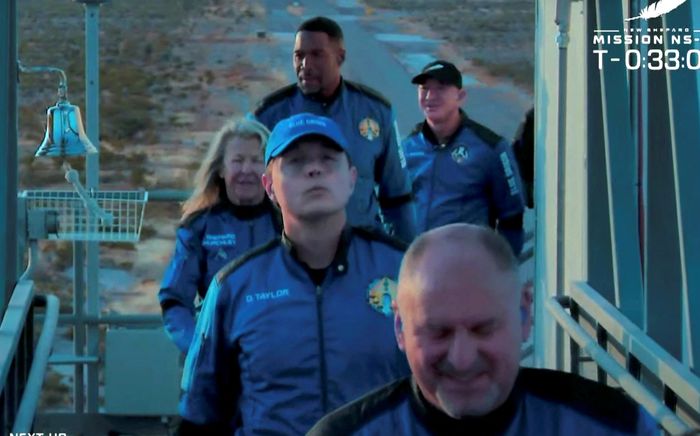Jeff Bezos’s Blue Origin LLC launched six people to the edge of space for a few minutes on Saturday, a trip that rounded out the busiest year for human flights in more than three decades.
The company’s latest tourism flight had four paying customers on board: space-industry executive Dylan Taylor; Evan Dick, an investor; and investor Lane Bess and his child. Two guests who didn’t pay for their seats were along for the ride as well: “Good Morning America” co-host Michael Strahan and Laura Shepard Churchley, the eldest daughter of Alan Shepard, who in 1961 became the first American to reach space.
Originally, the group was scheduled to fly on Thursday, but Blue Origin moved the launch time to Saturday morning because of windy conditions. The rocket blasted off just after 10 a.m. ET, according to the company, with the trip lasting slightly more than 10 minutes from launch to touchdown.
The flight was the 13th human space mission this year, a record surpassing the previous high of 11 launches in 1985, according to data maintained by Jonathan McDowell, an astrophysicist at the Harvard-Smithsonian Center for Astrophysics.

Jeff Bezos followed the group as they prepared for the Blue Origin flight.
Photo: BLUE ORIGIN/via REUTERS
This year’s number includes five trips managed by either the Chinese and Russian governments, such as the Russian space agency’s launch earlier this week of a crew that included Japanese billionaire Yusaku Maezawa to the International Space Station.
It also includes missions handled by a trio of private companies based in the U.S. In July, Virgin Galactic Holdings Inc. flew billionaire founder Richard Branson and five others to the edge of space. Blue Origin sent a crew including Mr. Bezos, its billionaire founder, up shortly thereafter, and launched actor William Shatner and three others in October.
SpaceX twice blasted astronauts to the space station for the National Aeronautics and Space Administration, and in September flew four private astronauts to orbit for the first-ever all-civilian orbital trip.

The Blue Origin capsule landed by parachute in West Texas.
Photo: BLUE ORIGIN/via REUTERS
The pace of human launches in 2021 “is precisely what we’ve been working on—what I and many others in the industry have been working on—for the last 20 years,” said Rob Meyerson, the former president at Blue Origin. He predicted the number of human space flights will increase in the coming years given the capabilities space-transport companies have developed.
Private space travel remains out of reach for the majority of people, given current ticket prices and relatively limited capacity in terms of vehicles available and licensed spaceports.
Axiom Space Inc., a Houston-based company developing its own space facility, is charging $50 million to $55 million for each seat to arrange private-astronaut missions on SpaceX rockets to the current space station, according to a person familiar with the matter.
Virgin Galactic has said its suborbital tourist flights will cost at least $450,000 a seat. Blue Origin hasn’t discussed prices for its launches. In July, Mr. Bezos said the company was approaching $100 million in sales for its tourist space trips.
Tom Vice, chief executive at Sierra Space, said tourism trips are expected to be a big part of the company’s business in the future. The company, part of contractor Sierra Nevada Corp., recently raised $1.4 billion to use in part to continue developing the Dream Chaser Spaceplane, a reusable spacecraft designed to land like a commercial jet.
“The challenge you have to get through is it is an early adopter model,” with wealthier people serving as the first customers, he said in a recent interview. “If we can get the price down, we can literally have hundreds of thousands of people, if not millions of people, who want to get into space.”
SHARE YOUR THOUGHTS
Will billionaire-funded space trips help or hinder space exploration? Join the conversation below.
Like its two previous tourism trips this year, Blue Origin on Saturday used its reusable New Shepard rocket to blast a crew capsule from a launchpad in West Texas past the Karman line, an internationally recognized boundary for space that starts around 62 miles above Earth. Those on board got a chance to float in zero gravity conditions for a few minutes and peer back at Earth.
“It was beyond,” Mr. Strahan said shortly after he and the other passengers emerged from the crew capsule.
Mr. Taylor, chief executive of Voyager Space and a longtime advocate for space exploration, said prior to the trip that he had dreamed of visiting space since he was a child. He said suborbital trips like the one experienced through Blue Origin will be a steppingstone to longer journeys.
“If we’re going to really get out there, which is what my passion is, you’ve got to take the first steps and suborbital leads to more orbital. And more orbital leads to more lunar and more lunar leads to more deep space,” he said.
Write to Micah Maidenberg at [email protected]
Copyright ©2021 Dow Jones & Company, Inc. All Rights Reserved. 87990cbe856818d5eddac44c7b1cdeb8








